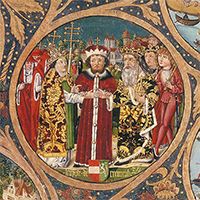Leopold VI: Duke of Austria
Leopold VI was the fourth Duke of Austria, ruling for more than three decades at the beginning of the 13th Century. 
He was born in 1176, to Duke Leopold V and Helena of Hungary. He was his parents' second-oldest child, after his brother Frederick. Leopold V was much involved in things in foreign lands. He had gone on a pilgrimage to the Holy Land in 1182 and then met with the Byzantine emperor, Alexios II Komnenos. Henry returned to the Holy Land in 1190, as part of the Third Crusade. His arrival delayed by bad weather, he arrived just as the Siege of Acre was winding down, in spring 1191. When the emperor's son Frederick, Duke of Swabia died, Leopold took control of the imperial troops besieging Acre. Actions taken by fellow Crusader King Richard I of England created an enmity between Richard and Leopold, and the latter captured the former, holding him for ransom. Leopold died in 1194, after the ransom had been paid. At that point, Frederick became Duke of Austria. As he was dying, Leopold ordered his lands divided, so his younger son, Leopold, got control of the Duchy of Styria. Frederick still ruled the Duchy of Austria, but that duchy was smaller than it had been. Leopold had also insisted that marry Richard's niece Eleanor. She was on her way to Austria when Leopold died; Frederick canceled the marriage agreement, and Eleanor did not complete the trip. Pope Celestine III had excommunicated Leopold for taking another Crusader prisoner. Frederick had inherited that enmity, which was enhanced by the fact that Richard demanded the ransom money back but Frederick couldn't provide all of it because Leopold had already spent a part of it. To make amends, Frederick offered to go on another Crusade. He joined the forces of Holy Roman Emperor Henry VI, leaving in 1197. These Crusaders had rather more success than many of their predecessors, taking Sidon and Tyre and marching on Damascus. The sudden death of Henry VI ended the Crusade, however, as a large number of the German force returned home. Frederick was in Acre on April 16, 1198, when he died. Frederick had not married and had no children. Leopold then succeeded him as Duke of Austria, reuniting the two lands. He had been involved in a succession dispute in Hungary, supporting Andrew II against his brother, Emeric; papal mediation eventually ended this dispute, and Leopold maintained good relations with both brothers. Like father and brother before him, Leopold, too, went on Crusade, twice. He joined the Albigensian Crusade, in 1212, targeting Cathars in France. He also joined the Fifth Crusade, which lasted from 1217 to 1221. In between the two, he led a group of soldiers to fight alongside fellow Christians in the Reconquista, Spanish nobles' attempt to retake lands controlled by Moors for many generations. Leopold had married Theodora Angelina, a Byzantine princess, in 1203. They had seven children, six of whom lived into adulthood: Margaret (1204), Agnes (1205), Henry (1208), Gertrude (1210), Frederick (1211), and Constantia (1212). Leopold had returned home from the Fifth Crusade and was busy elevating the status and prestige of his duchy. His reputation was such that he was considered a worthy mediator for a dispute between Holy Roman Emperor Frederick II and Pope Gregory IX. Leopold succeeded in getting the two men to reconcile, on July 23, 1230. He died five days later, in San Germano. His oldest son, Henry, had died two years before; thus, succeeding Leopold as Duke of Austria was his son Frederick. |
|
Social Studies for Kids
copyright 2002–2025
David White




